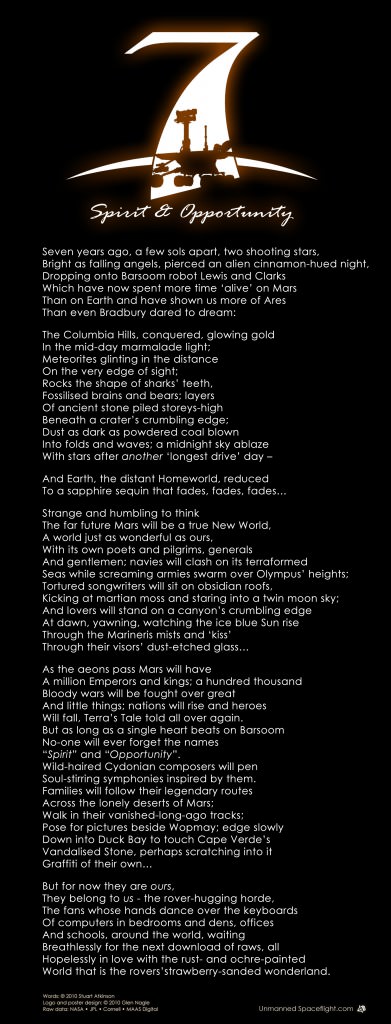The folks from the HiRISE Camera on the Mars Reconnaissance Orbiter have put together a video with some groovin’ music of the latest images from the Red Planet, courtesy of HiRISE, the bestest camera in all of Marsdom. There’s an elliptical impact crater, giant gullies, sinuous ridges and a Swiss Cheese smiley face. No foolin’!
7 Years of Opportunity on Mars and a Science Bonanza
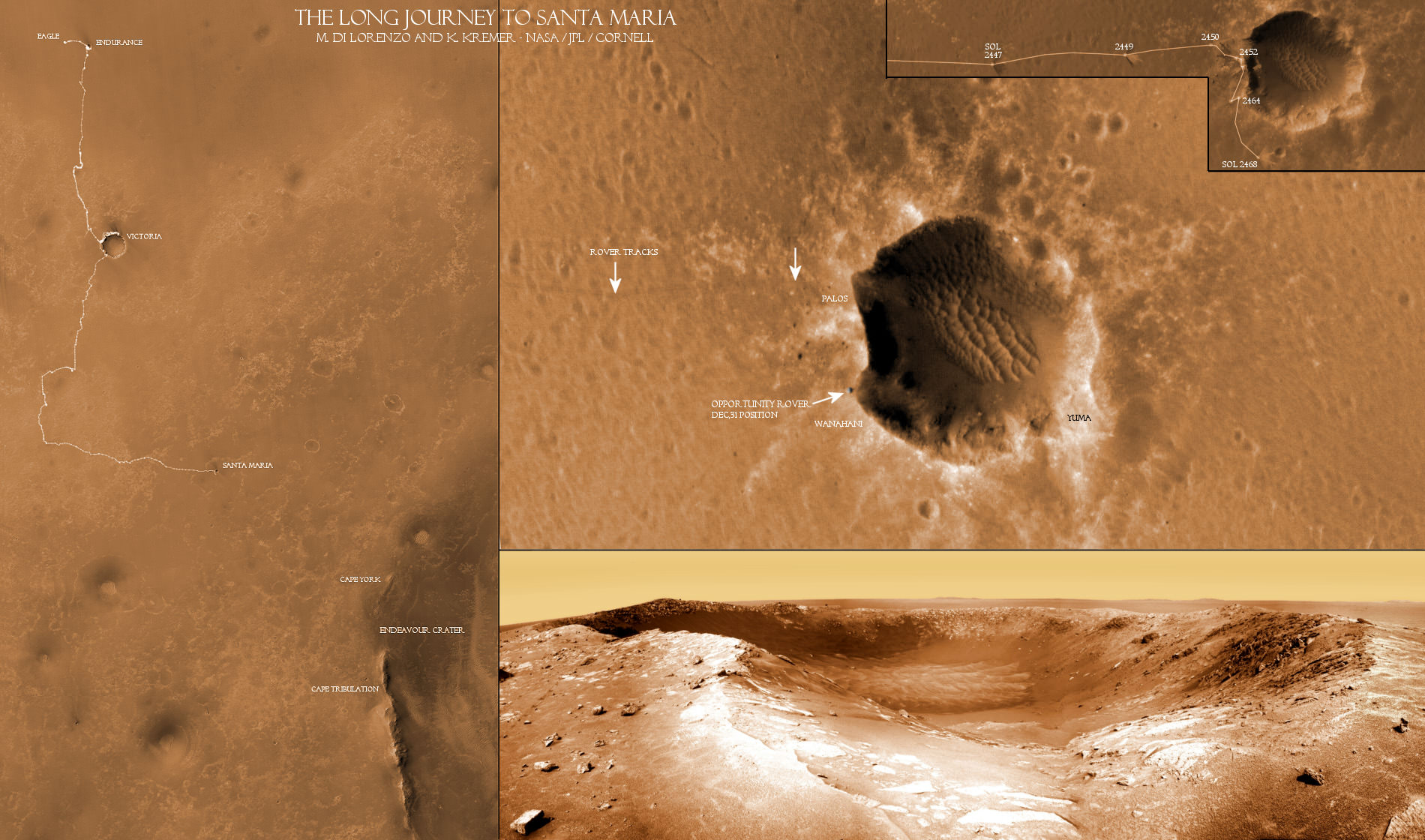
[/caption]
Today, Jan. 24, 2011 marks the 7th anniversary of the safe landing of the Opportunity Mars Exploration Rover (MER). Opportunity will soon celebrate another remarkable milestone – 2500 Sols, or Martian days, roving the red planet. Together with her twin sister Spirit, the NASA rovers surely rank as one of the greatest feats in the annals of space exploration.
“No one expected Spirit or Opportunity to go on this long,” says Ray Arvidson in an interview from Washington University in St. Louis. Arvidson is the deputy principal investigator for the Spirit and Opportunity rovers.
7 Years ago today on Jan. 24, 2004, NASA’s Opportunity rover daringly smashed into the Martian atmosphere at about 12,000 MPH on a one shot, do or die mission with no certainty as to the outcome. Thus began “The Six Minutes of Terror” as the plummeting probes heat shield endured temperatures exceeding 1400°C (2600 F) during the fiery entry, descent and landing phase (EDL).
The spectacular plunge was slowed by atmospheric friction on the heat shield and a complex pre-programmed combination of parachutes and retro rockets, and in the last moments by inflatable airbags designed to allow the robot to bounce about two dozen times and gently and gradually roll to a complete stop.

This high-resolution image captured by the Mars Exploration Rover Opportunity's panoramic camera on Sol 3 highlights the puzzling rock outcropping that scientists were eagerly planning to investigate after safely landing. Opportunity was on its lander facing northeast; the outcropping lies to the northwest. These layered rocks measure only 10 centimeters (4 inches) tall and are thought to be either volcanic ash deposits or sediments carried by water or wind. Data from the panoramic camera's near-infrared, blue and green filters were combined to create this approximate, true-color image. Image credit: NASA/JPL/Cornell
Ultimately, Opportunity survived intact just like her twin sister Spirit who landed safely three weeks earlier on Jan. 3, 2004. EDL was the culmination of a seven month interplanetary cruise of over 250 million miles from Earth. Both rovers were launched from Cape Canaveral, Florida in the summer of 2003 on board Delta 2 rockets. The dynamic duo landed on opposite sides of the Red planet.
Opportunity is now 84 months into the 3 month mission – still alive and blazing a trail of Exploration and Discovery across the Meridiani Planum region of Mars.
The amazing Martian robot has driven more than 16.5 miles (26.7 km) and snapped over 148,000 pictures. She has suffered remarkable few mechanical failures and they have only minimally impaired her ability to traverse across the surface and conduct science operations.
Both rovers survived far beyond the mere 3 month “warranty” proclaimed by NASA as the mission began with high hopes following the nail biting “Six Minutes of Terror”. At the time, team members and NASA officials hoped they might function a few months longer.
“The rovers are our priceless assets” says Steve Squyres, of Cornell University who is the Principal Scientific Investigator for the mission. Squyres and the entire rover team treat every day with a “sense of urgency” and as “a gift to science”.
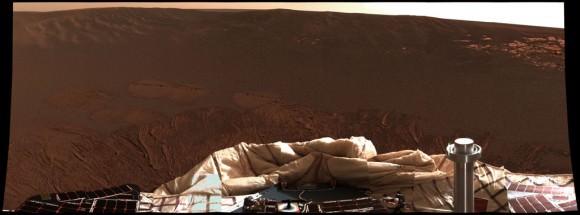
The interior of a crater surrounding the Mars Exploration Rover Opportunity at Meridiani Planum on Mars can be seen in this color image from the rover's panoramic camera. This is the darkest landing site ever visited by a spacecraft on Mars. The rim of the crater is approximately 10 meters (32 feet) from the rover. The crater is estimated to be 20 meters (65 feet) in diameter. Scientists are intrigued by the abundance of rock outcrops dispersed throughout the crater, as well as the crater's soil, which appears to be a mixture of coarse gray grains and fine reddish grains. Data taken from the camera's near-infrared, green and blue filters were combined to create this approximate true color picture, taken on the first day of Opportunity's journey. The view is to the west-southwest of the rover. Credit: NASA/JPL/Cornell
Since 2004, the rover’s longevity has surpassed all expectations and nobody on the science and engineering teams that built and operate the twins can believe they lasted so long and produced so much science.
“We have a new Opportunity overview article publishing shortly in the Journal of Geophysical Research (JGR). The Spirit overview paper appeared recently. In addition, there will be about 24 new scientific papers coming out in the new few months as JGR special issues covering more of the MER results. ”
The incredible longevity is “way beyond the wildest expectations of even the people who built the twin sisters” according to fellow Cornell University Professor Jim Bell. “To say the rovers have surpassed expectations is an understatement. We’ve blown them out of the water”. Bell is the lead scientist responsible for the rovers’ high resolution color imaging system called Pancam.
“After 7 years it is still very exciting,“ Arvidson told me. “I am delighted to come to work every day. It’s great to work on the engineering plan for driving and operating the rovers and then see the results the next day.”
Spirit and Opportunity have accomplished a remarkable series of scientific breakthroughs, far surpassing the wildest dreams of all the researchers and NASA officials. Indeed both Mars rovers are currently stationed at scientific goldmines.
Opportunity is currently exploring the outskirts of the stadium sized ‘Santa Maria’ Carter – some 295 feet wide (90 m) – which holds deposits of water bearing minerals that will further elucidate the potential for habitability on the red planet.
The rover arrived at the western edge of the relatively fresh impact crater on Dec. 16, 2010 (Sol 2451). This intermediate stop on the rovers 19 km long journey from Victoria Crater to giant 22 km wide Endeavour Crater will provide important ground truth observations to compare with the orbital detection of exposures of hydrated sulfate minerals. Read more on Santa Maria in the next feature story.
Santa Maria is just 6 km from the western rim of Endeavour which shows spectral signatures of phyllosilicates, or clay bearing minerals, which formed in water about 4 billion years ago and have never before been directly analyzed on the Martian surface.
Phyllosilicates form in neutral aqueous conditions that could have been more habitable and conducive to the formation of life than the later Martian episodes of more harshly acidic conditions in which the sulfates formed that Opportunity has already been exploring during her 7 year long overland expedition.
Since the moment she landed inside ‘Eagle’ crater, Opportunity has been on a Martian crater tour her entire lifetime.
Opportunity “scored a 300-million mile interplanetary hole in one,” Steve Squyres said at that time, by improbably rolling to a stop smack inside the small 66 foot wide ‘Eagle’ crater (see map) after bouncing across the virtually flat and featureless dusty plains of Meridiani. She has been a lucky princess from the moment of her birth, spying layered sedimentary rocks in a bedrock outcrop from first light in her cameras a mere 26 feet or so away. That’s unlike any previous lander.

Seven days later she drove off the landing pad, drilled into the outcrops and collected the “ground truth” science data to prove that hematite was present and liquid water had indeed flowed at Meridiani as a lake or shallow sea on ancient Mars.
After completing her science campaign, she climbed up and over the rim, departed ‘Eagle’ and arrived at ‘Endurance’ about 3 months after landing day.
After numerous tests, Opportunity was commanded to slowly crawl down into the crater. She gradually descending about 30 vertical feet, frequently drilling into the sedimentary rocks and layers to reveal Mars watery past in unprecedented scientific detail for about six months.
In Dec. 2004, Opportunity departed for “Victoria” crater, which many believed would be her final destination. The robot nearly perished in a sand trap at Purgatory along the way during a nearly two year drive across the treacherous martian sand dunes.
Opportunity arrived in Sept. 2006 to unveil Victoria’s Secrets in color. The rover actually wound up spending two years driving to different vantage points around the rim of and then inside the half mile wide crater before departing in Sept 2008 for the unimaginable goal of giant ‘Endeavour’ crater.
The rover team hopes to reach the slopes of Endeavour sometime later in 2011 if all goes well – before her 8th anniversary !
See below some of the best images taken by Opportunity during her 7 Year Martian Trek

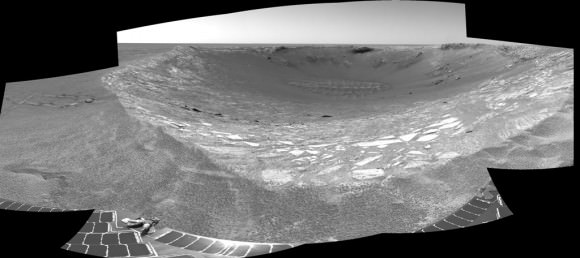
This view looking was taken by the navigation camera on June 6, 2004. That was two sols before Opportunity entered the crater, taking the route nearly straight ahead in this image. This view is a cylindrical projection with geometric seam correction. Credit: NASA/JPL
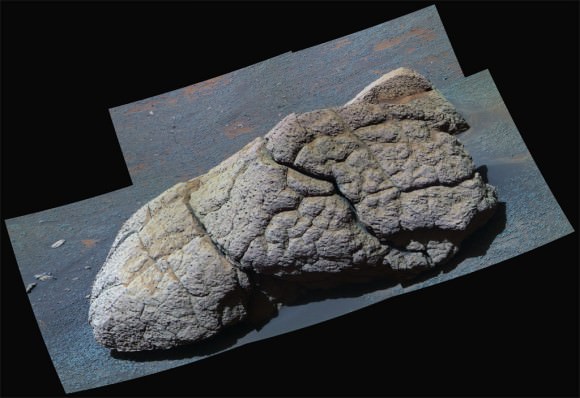
NASA's Mars Exploration Rover Opportunity examined a boulder called Wopmay before heading further east inside Endurance Crater. The frames combined into this false-color view were taken by Opportunity's panoramic camera during the rover's 251st martian day (Oct. 7, 2004). The coloring accentuates iron-rich spherical concretions as bluish dots embedded in the rock and on the ground around it. The rock is about one meter (3 feet) across. Credit: NASA/JPL/Cornell
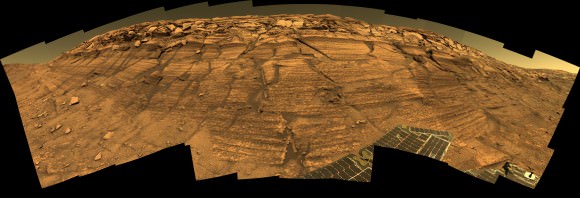
Opportunity captured this view of Burns Cliff after driving right to the base of this southeastern portion of the inner wall of Endurance Crater. The view combines frames taken by Opportunity's panoramic camera between the rover's 287th and 294th martian days (Nov. 13 to 20, 2004). The mosaic spans more than 180 degrees side to side. Because of this wide-angle view, the cliff walls appear to bulge out toward the camera. In reality the walls form a gently curving, continuous surface. Image credit: NASA/JPL/Cornell
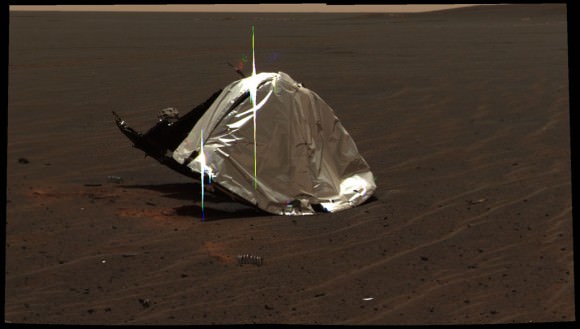
This image from the panoramic camera on NASA's Mars Exploration Rover Opportunity features the remains of the heat shield that protected the rover from temperatures of up to 2,000 degrees Fahrenheit as it made its way through the martian atmosphere. This two-frame mosaic was taken on Sol 335 (Jan. 2, 2005). The view is of the main heat shield debris seen from approximately 10 meters (about 33 feet) away from it. Many rover-team engineers were taken aback when they realized the heat shield had inverted, or turned itself inside out. The height of the pictured debris is about 1.3 meters (about 4.3 feet). The original diameter was 2.65 meters (8.7 feet), though it has obviously been deformed. The Sun reflecting off of the aluminum structure accounts for the vertical blurs in the picture.
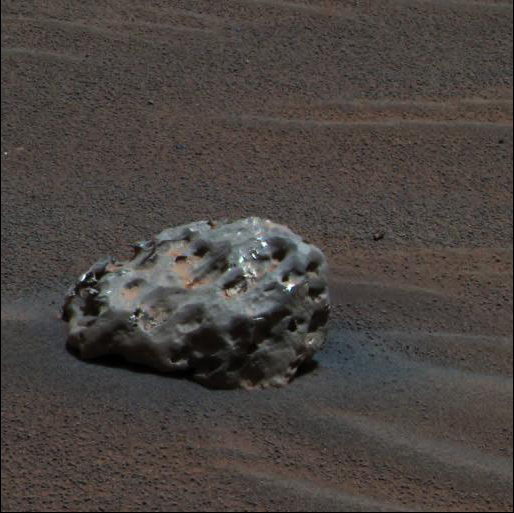
Opportunity finds an iron meteorite on Mars, the first meteorite of any type ever identified on another planet. The pitted, basketball-size object is mostly made of iron and nickel. Opportunity used its panoramic camera to take the images used in this approximately true-color composite on the Sol 339 (Jan. 6, 2005). Credit: NASA/JPL/Cornell
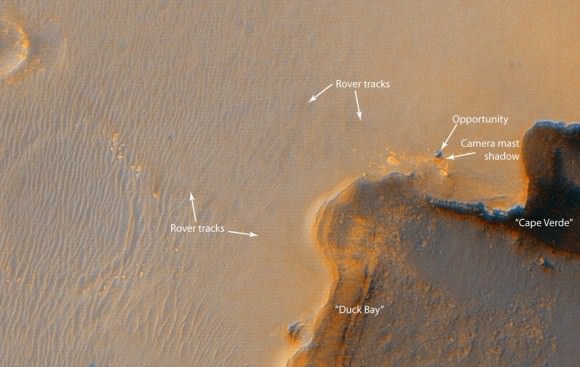
This image from the High Resolution Imaging Science Experiment on NASA's Mars Reconnaissance Orbiter shows the Mars Exploration Rover Opportunity near the rim of Victoria Crater. Victoria is an impact crater about 800 meters (half a mile) in diameter at Meridiani Planum near the equator of Mars. Five days before this image was taken, Opportunity arrived at the rim of Victoria, after a drive of more than 9 kilometers (over 5 miles). It then drove to the position where it is seen in this image. This view is a portion of an image taken by the High Resolution Imaging Science Experiment (HiRISE) camera onboard the Mars Reconnaissance Orbiter spacecraft on Oct. 3, 2006. Credit: NASA/JPL/UA

This Opportunity panorama reveals 2,500 ft-wide, 230 ft-deep Victoria Crater from the lip at Duck Bay alcove. Geologic layers reveal the history of Martian water here. The panorama was taken about 8 feet from the crater rim on Sol 952 (28 Sept 2006) as the rover sat between two steep promontories, Cape Verde and Cabo Frio. This vista exposes a thick stack of geologic layers which revealed the hidden watery secrets of the Martian environment farther back in time than any other location visited previously by the rovers. One can see a ½ mile to the distant cliff walls of the crater, above a windswept dune field in the center. This mosaic was assembled from navcam images and featured in Aviation Week & Space Technology magazine and on the Astronomy Picture of the Day (APOD) on 2 Oct. 2006 in high resolution. Credit: NASA/JPL/Cornell, Bernhard Braun, Marco Di Lorenzo, Kenneth Kremer. http://antwrp.gsfc.nasa.gov/apod/ap061002.html
Check out this spherical projection panorama of Opportunity descending inside Victoria Crater on Sol 1332. Credit: NASA/JPL/Cornell/Nasatech.net

This view of Victoria crater is looking north from Duck Bay towards the dramatic promontory called Cape Verde. The dramatic cliff of layered rocks is about 50 meters (about 165 feet) away from the rover and is about 6 meters (about 20 feet) tall. The taller promontory beyond that is about 100 meters (about 325 feet) away, and the vista beyond that extends away for more than 400 meters (about 1300 feet) into the distance. This is an approximately true color rendering of images taken by the panoramic camera (Pancam) on NASA's Mars Exploration Rover Opportunity during Sol 952 (Sept. 28, 2006) using the camera's 750-nanometer, 530-nanometer and 430-nanometer filters. Credit: NASA/JPL/Cornell
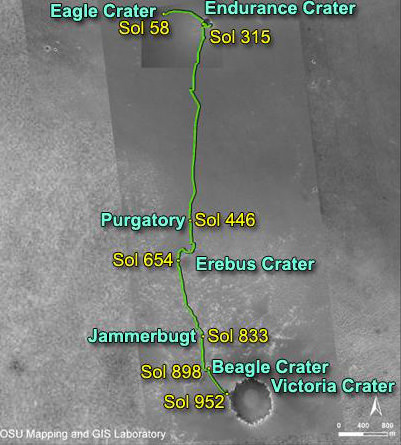
NASA's Mars Exploration Rover Opportunity reached the rim of Victoria Crater on Sept. 28, 2006, Sol 952. Opportunity drove 9.28 kilometers (5.77 miles) in the explorations that took it from Eagle Crater, where it landed in January 2004, eastward to Endurance Crater, which it investigated for about half of 2004, then southward to Victoria.

During four months prior to the fourth anniversary of its landing on Mars, Opportunity examined rocks inside an alcove called Duck Bay in the western portion of Victoria Crater. The main body of the crater appears in the upper right of this panorama, with the far side of the crater lying about 800 meters (half a mile) away. Bracketing that part of the view are two promontories on the crater's rim at either side of Duck Bay. They are Cape Verde, about 6 meters (20 feet) tall, on the left, and Cabo Frio, about 15 meters (50 feet) tall, on the right. This view combines many images taken by Opportunity's panoramic camera (Pancam) from the Sol 1,332 through 1,379. (Oct. 23 to Dec. 11, 2007).
Relive Opportunity’s landing:
New Looks at Phobos from Mars Express Flyby
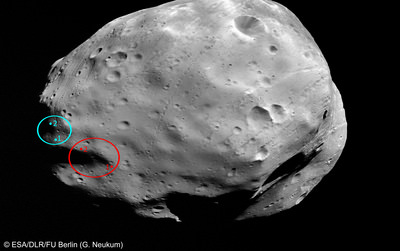
[/caption]
The Mars Express team released the images today from the close flyby the spacecraft made of Phobos on January 9. The images weren’t downloaded from Mars Express until Jan. 18, and then they were processed, so these are hot off the press. The team didn’t provide much explanation, but enjoy the images. There’s one 3-D view in the group, so grab your 3-D glasses.


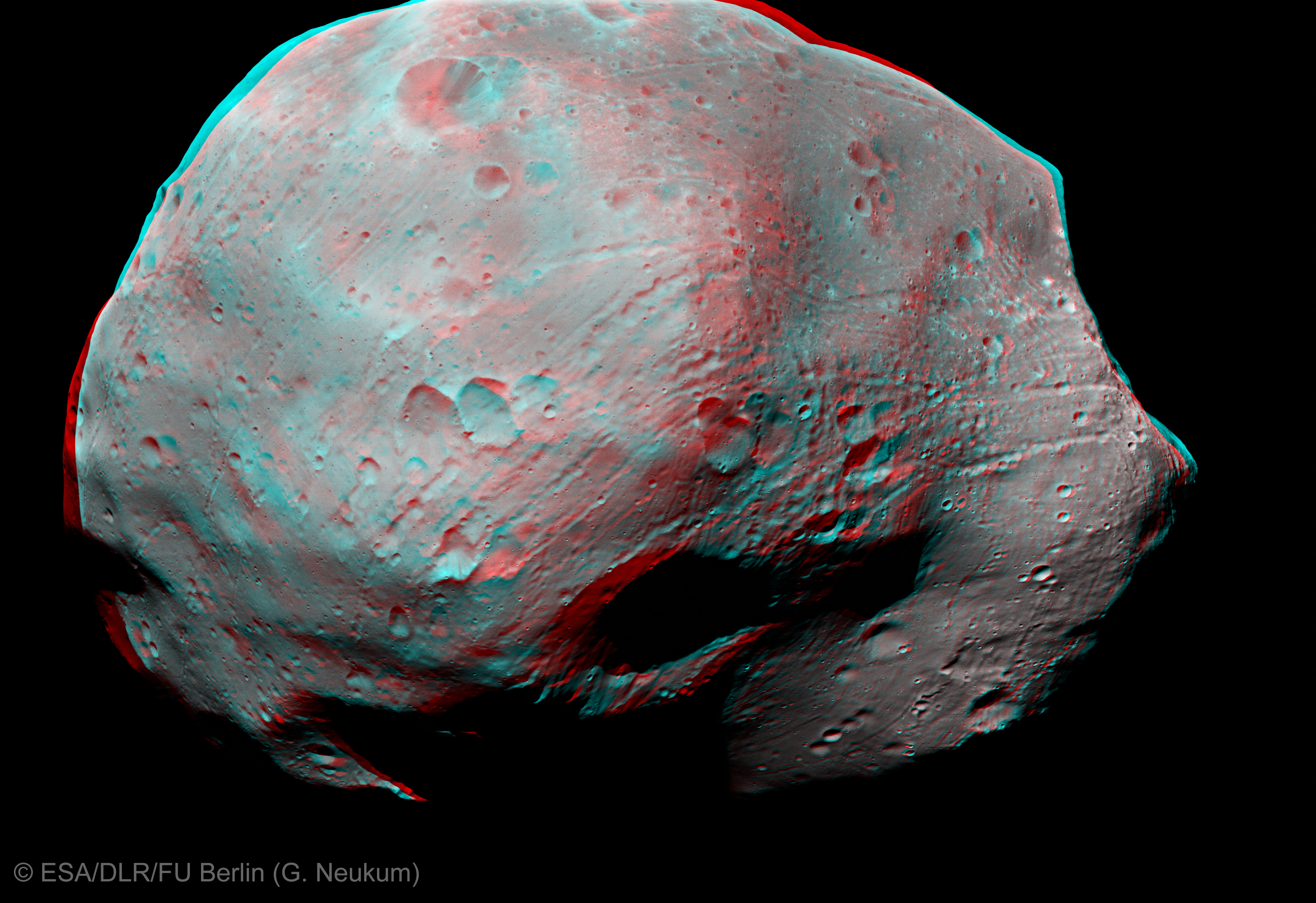
Here’s the on 3-D view, and the team explained that due to the stereo viewing geometry during the flyby a small part of the moon’s edge is only visible for the right eye resulting in odd 3D-perception in this area. This part has been slightly adjusted for better viewing. Also, for the left eye at the left edge of the image four small data gaps have been interpolated.

Source: ESA
Drop Test for Next Mars Rover’s Sky-Crane Landing System
One of the biggest unknowns for the Mars Science Lab — a.k.a Curiosity — is the landing system, called the Sky Crane, which has never been used before for a spacecraft landing on another planet. It is similar to a sky crane heavy-lift helicopter, and it works like this: after a parachute slows the rover’s descent toward Mars, a rocket-powered backpack will lower the rover on a tether during the final moments before landing. This method allows landing a very large, heavy rover on Mars (instead of the airbag landing systems of previous Mars rovers).
The MSL team conducted a drop test of the Sky Crane, and you can see how it worked in the video, above.
Continue reading “Drop Test for Next Mars Rover’s Sky-Crane Landing System”
NASA Redoubling Efforts to Contact Spirit
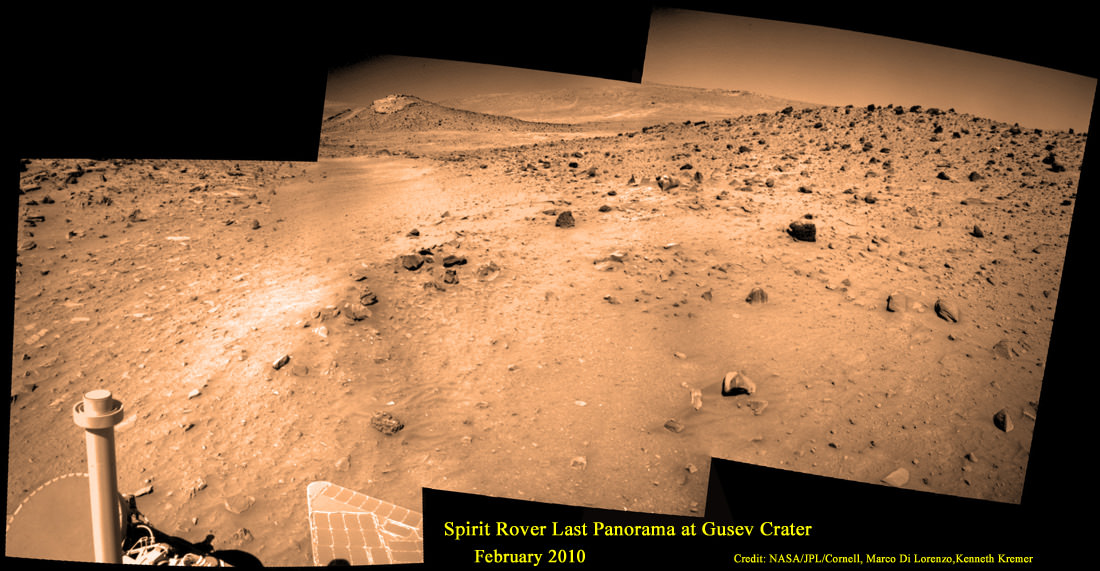
[/caption]
No one is giving up hope for Spirit. Not Yet. And neither should you.
It’s too soon to turn out the lights. Indeed NASA is stepping up operational efforts to contact the plucky rover – More communications commands; more listening time; more frequencies. Spirit last communicated with mission controllers back on Earth on March 22, 2010. The rover entered hibernation mode – some nine months ago – as the available sunlight to power the life giving solar panels was diminishing. NASA hopes to reawaken Spirit from a long slumber and reignite her breakthrough campaign of exploration and discovery from a scientific goldmine on the surface of the red planet.
“The sun is still rising on Mars,” says Ray Arvidson in an interview from Washington University in St. Louis. Arvidson is the deputy principal investigator for the Spirit and Opportunity rovers.
“We will keep listening for many months if necessary,” Steve Squyres informed me. Squyres is the Principal Scientific Investigator for the Mars Exploration Rover mission.
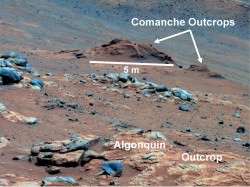
Data from Spirit collected in late 2005 has confirmed that an outcrop called Comanche contains a mineral indicating that a past environment was wet and non-acidic, possibly favorable to life.
Spirit captured this view of the Comanche outcrop during Sol 689 on Mars (Dec. 11, 2005). The rover's Mössbauer spectrometer, miniature thermal emission spectrometer and alpha particle X-ray spectrometer each examined targets on Comanche.
About one-fourth of the composition of Comanche is magnesium iron carbonate. That concentration is 10 times higher than for any previously identified carbonate in a Martian rock. Carbonates originate in wet, near-neutral conditions, but dissolve in acid. The find at Comanche is the first unambiguous evidence from either Spirit or Opportunity for a past Martian environment that may have been more favorable to life than the wet but acidic conditions indicated by the rovers' earlier finds. Credit: NASA/JPL-Caltech/Cornell University
By the time of the last dispatch from Mars, Spirit had lasted for nearly six years of bonus mission time – during the extended mission phase – light years beyond the 3 month “warranty” proclaimed by NASA as the mission began back in January 2004.
At Spirit’s location in the southern hemisphere of Mars, Southern Summer has not yet arrived. Right now it’s mid Southern Spring and daylight hours are increasing. And Summer doesn’t even start until mid-March 2011. The question is whether Spirit’s unheated electronics components have endured the extremely harsh and frigidly cold conditions of her 4th winter on Mars – her coldest ever. At about -100 C … Imagine Antarctica !
“The amount of solar energy available for Spirit is still increasing every day for the next few months,” said Mars Exploration Rover Project Manager John Callas of NASA’s Jet Propulsion Laboratory (JPL) , Pasadena, Calif. “As long as that’s the case, we will do all we can to increase the chances of hearing from the rover again.”
“We’re stepping up our efforts to contact Spirit — doubling down on her, as it were,” tweeted JPL mars rover driver Scott Maxwell.
And all those negative stories you may have read about Spirit being “Still Stuck” … well they totally missed the point.
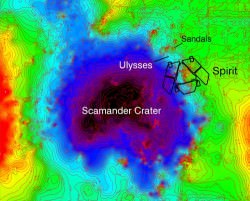
In the final Sols, or Martian days, before falling silent in March 2010, there was dramatic movement by Spirit. “During the last 9 drives, Spirit actually moved 34 cm. That’s pretty good for a stationary rover,” Arvidson said.
This movement came despite the loss of two of the rover’s six wheels and after many months of methodical testing in the “Mars sand box”. Engineers at JPL devised and tested numerous strategies in attempting to extricate Spirit from the sand trap of soft soil in which she became mired.
Because of the declining sun and available power, Spirit basically just ran out of time to try and completely escape from the sand trap. This left it unable to obtain a favorable tilt for solar energy during the rover’s fourth Martian winter, which began last May.
Many members of the rover team are hopeful that they can indeed “Free Spirit” if she awakens from her current hibernation mode.
“I have no idea whether we’ll hear from Spirit again or not… there’s simply no way to predict it,” Squyres told me. “We will keep listening for many months. All we can do is listen”
Even if we never hear from Spirit again, she has accomplished a remarkable series of scientific breakthroughs, far beyond the wildest dreams of the science and engineering teams that built and operate the twins.
Both rovers have made important discoveries about wet environments on ancient Mars that may have been favorable for supporting microbial life.
Spirit discovered a rock that contained high levels of carbonates, minerals that form in neutral watery conditions that are far more conducive to the formation of life than the acidic watery conditions reported earlier in the mission.
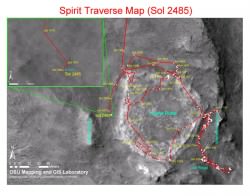
Although Spirit has been stalled at a place called ‘Troy’ since April 2009. she made a significant science discovery at that exact spot. Spirit examined the soil in great detail and found key evidence that water, perhaps as snow melt, trickled into the subsurface fairly recently and on a continuing basis.
While driving on the western edge of an eroded over volcanic feature named ‘Home Plate’, she unknowingly broke through a hard surface crust (perhaps 1 cm thick) and sank into hidden soft sand beneath. At ‘Troy’, Spirit discovered that the crust was comprised of water related sulfate materials and therefore found evidence for the past flow of liquid water on the surface of Mars – a great science discovery!
After mid-March, prospects for reviving Spirit would begin to drop, say NASA officials. Communication strategies would change based on reasoning that Spirit’s silence is due to factors beyond just a low-power condition. Mission-ending damage from the cold experienced by Spirit in the past Martian winter is a real possibility.
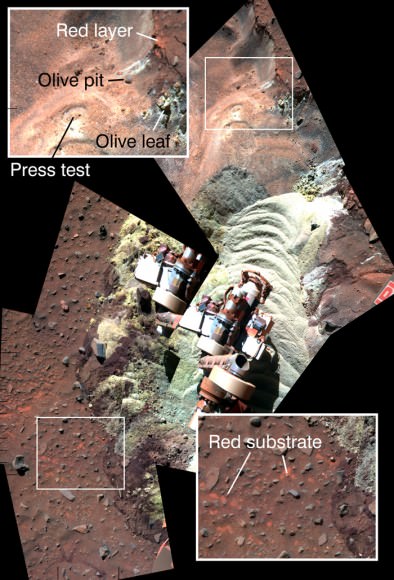
Spirit's panoramic camera (Pancam) took the component images during the period from the 2,163rd to 2,177th Martian days, or sols, of Spirit's mission on Mars (Feb. 2 to Feb. 16, 2010). The turret at the end of the rover's arm appears in two places because of movement during that period. Insets in the upper left and lower right corners of the frame show magnified views of the nearby inscribed rectangles within the mosaic. The patch of ground within each rectangle is about 25 centimeters (10 inches) across. The top inset and upper portion of the mosaic include targets within soil layers exposed by the action of Spirit's wheels in April 2009 and examined in detail with instruments on Spirit's arm during the five subsequent months.
Olive pit and Olive leaf are two of the analyzed targets. The investigations determined that, under a thin covering of windblown sand and dust, relatively insoluble minerals are concentrated near the surface and more-soluble ferric sulfates have higher concentrations below that layer. This pattern suggests water has moved downward through the soil, dissolving and carrying the ferric sulfates. The brightness and color of the freshly disturbed soil seen in the center area of the mosaic indicates the this formerly hidden material is sulfate-rich. Before Spirit drove into this patch, the surface looked like the undisturbed ground highlighted in the lower-right inset. Flecks of red material in the surface layer resemble the appearance of the surface layer at other locations where Spirit's wheels have exposed high-sulfate, bright soils. Image Credit: NASA/JPL-Caltech/Cornell University
Spirit entered a low-power fault mode in March 2010 with minimal activity except charging and heating the batteries and keeping its clock running. With most heaters shut off, Spirit’s internal temperatures dipped lower than ever before on Mars. That stress could have caused damage, such as impaired electrical connections, that would prevent reawakening or, even if Spirit returns to operation, would reduce its capabilities.
“Components within the rover electronic module (REM) inside the rover’s warm electronic box (WEB) are experiencing record low temperatures,” said Doug McCuistion, the director of Mars Exploration at NASA Headquarters in Washington, DC, in an interview about Spirit’s predicament. “The expectation is for the REM hardware to reach -55C at the coldest part of the winter. We have tested the REM down to -55C”.
NASA’s Deep Space Network of antennas in California, Spain and Australia has been listening for Spirit daily in coordination with the spacecraft orbiting Mars; Mars Odyssey and Mars Reconnaissance Orbiter. In X-band, the DSN listens for Spirit during one pass each day. The rover team has also been sending commands to elicit a response from the rover even if the rover has lost track of time.
Now, the monitoring is being increased. Additional listening periods include times when Spirit might mistake a signal from NASA’s Mars Reconnaissance Orbiter as a signal from Earth and respond to such a signal. Commands for a beep from Spirit will be sent at additional times to cover a wider range of times-of-day on Mars when Spirit might awaken.
“DSN does an average of 4 “sweep & beep” commands in each day’s pass,” according to JPL spokesman Guy Webster. Also, NASA is listening on a wider range of frequencies to cover more possibilities of temperature effects on Spirit’s radio systems
Opportunity is still blazing a trail of discovery on the opposite side of Mars. She is currently exploring the stadium sized Santa Maria Carter which holds deposits of water bearing minerals that will further elucidate the potential habitability on the red planet.
For current updates about Opportunity’s exciting view from the steep walled crater and while being simultaneously imaged from Mars orbit in exquisite high resolution, read my earlier stories.
Mars Express Set for Phobos Flyby
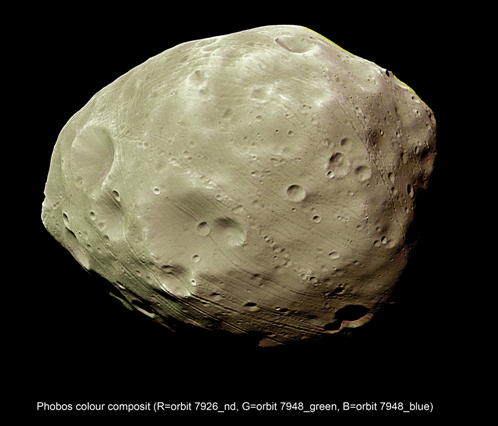
[/caption]
The Mars Express spacecraft will be making a very close flyby of the moon Phobos Sunday, January 9, 2011, at a distance of only 111 km from the center of the moon. The spacecraft actually is having eight different fairly close flybys of Phobos between December 20, 2010 and 16 January 2011, but this is the closest of that group. The Sunday buzz-by will be the third closest that Mars Express has performed during its time in orbit at Mars. The flyby speed will be about 3 km/s.
Olivier Witasse, ESA Project Scientist for Mars Express did a Q&A about the flyby with the Mars Express blog, which we’ll post below.
Q: What is the prime objective of this fly-by?
Witasse: The prime objective is to obtain high-resolution data from all remote sensing instruments, and especially to acquire what we hope will be spectacular images using the High Resoultion Stereo Camera (HRSC).
Q: What do the camera team hope to achieve?
Witasse: The HRSC camera will cover the southern hemisphere, which has not been well imaged during previous encounters. It should achieve a ground resolution of about a few metres per pixel. The emphasis will be on stereo imaging. These new data will improve the Phobos elevation model. This time, no colour data will be taken.
Q: Will any other instruments be working?
Witasse: The OMEGA, PFS and SPICAM experiments will acquire new data in the ultraviolet, visible and infrared ranges. This will significantly improve a data set used to map the surface temperatures. Also, and this is very important, the data are being used to find out the composition of Phobos. This is a very difficult exercise, because the spectra lack the obvious signatures of known components such as minerals.
The MARSIS radar will also be working, attempting to obtain echoes from beneath the surface. To complete the picture, the ASPERA experiment will record signatures of the interaction between the solar wind and Phobos, by detecting solar wind particles bouncing off the surface.
All these new data can help unlock the origin of the Martian moons, and will certainly support the Russian sample return mission, Phobos-Grunt, expected to be launched later this year. Unfortunately, the Phobos-Grunt landing site will be at the fringes of view this time and so poorly illuminated.
Q: Why no radio science this time?
Witasse: Given the design of the Mars Express spacecraft, we always have to make a choice between radio-science and remote sensing. In other words, we cannot point the camera towards the target and the high-gain antenna towards Earth at the same time.
For this particular flyby, at 111 km, we decided to give priority to remote sensing for many reasons. Flybys over the illuminated side of Phobos obviously favour the operations of the imagers and spectrometers. Also, the altitude of this flyby is not ideal for radio-science. To improve the gravity data set, we would need to fly below 60 km. Furthermore, at the moment Mars is far from Earth and close to the Sun (as seen from Earth), making the quality of radio-signal unsuitable for a detailed scientific analysis.
——————
In another blog post, the Mars Express team said to expect no pictures from the flyby until January 21, because the whole Phobos data set won’t be downloaded to Earth until January 18. The HRSC team will then process the data, and we can expect a release of images (including a 3D view) on Friday, 21 January.
Source: Mars Express Blog
Opportunity Photographed from Mars Orbit at Crater Precipice
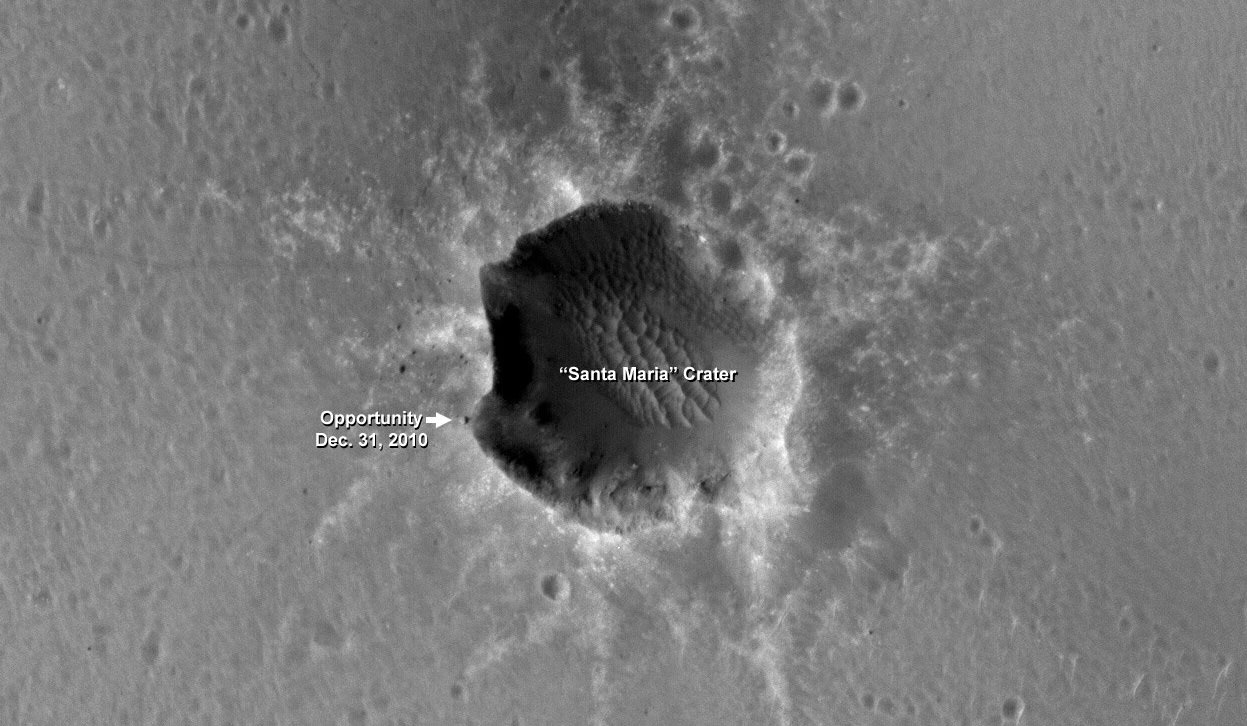
[/caption]
“I enjoy seeing our rover again,“ says Steve Squyres in an exclusive for Universe Today. Squyres is the top scientist for the Opportunity and Spirit Mars rovers.
NASA’s Opportunity rover was just been photographed from Mars Orbit while perched at the precipice of Santa Maria crater – just meters away from the edge of the Southwest rim. The photo was taken on New Year’s Eve, Dec. 31, 2010 on Sol 2466 of the mission which has lasted nearly 7 years ! Opportunity landed on Mars on Jan. 24, 2004.
This newly released photo was taken by the high resolution HiRISE camera circling overhead in Mars orbit aboard NASA’s Mars Reconnaissance Orbiter (MRO).
“Well, it’s always great to see images like that,” Steve Squyres just informed me after seeing the new photos of Opportunity. Squyres, of Cornell University, is the Principal Scientific Investigator for NASA’s Spirit and Opportunity Mars rovers.
“This one reminds me a lot of the first time we ever saw a rover from orbit, just after Opportunity had arrived at the rim of Victoria crater. It’s a very evocative scene, and it’s hard not to project certain things onto the rover (“valiant”, “lonely”) when you see it. Mostly, though, I just enjoy seeing our rover again.”
“The last time I laid eyes on Opportunity was about seven and a half years ago, and it’s nice getting another glimpse of her,” said Squyres.
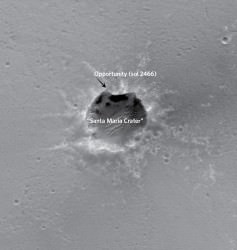
Opportunity arrived at the western rim of Santa Maria on Dec. 16 (Sol 2451) after a long and arduous trek of some 19 km since departing from Victoria Crater over 2 years ago in September 2008.
The rover has been exploring around the western portion of Santa Maria crater since arriving and is now heading to the southeast rim which possesses deposits of hydrated minerals.
Opportunity drove some 40 meters south along the steep rim from the initial location at “Palos” Promontory and then bumped incrementally further up to the edge on Sol 2464 at a place dubbed “Wanahani”.
The rover was photographed from Mars orbit while perched at “Wanahani” on New Years Eve, Dec 31, 2010 on Sol 2466.
“We are driving the vehicle in a counterclockwise direction around Santa Maria to reach the very interesting hydrated sulfates on the other side,” according to Ray Arvidson, the deputy principal investigator for the rovers, in an interview from Washington University in St. Louis. “We’ll make 3 stops or more depending on what we see”
Simultaneously to being photographed from orbit, the rover itself was of course merrily snapping a ground level view of Santa Maria. To experience the surface eye view from Opportunity, see our photo mosaic – stitched from the raw images – to display the rovers panoramic perspective whilst gazing outwards from “Wanahani” to the cliffs of Santa Maria on Sols 2464 and 2466.

Wanahani outlook at Santa Maria Crater. Opportunity took this panaromic mosaic from “Wanhani” just meters from the crater rim on Dec 29, 2010 (Sol 2464). Note rover tracks near rim at left, relatively clean solar panel at right and numerous ejecta rocks. The rim is inclined roughly 5 degrees here. CRISM mapper results suggest water bearing materials are located at the southeastern edge of the crater rim, nicknamed “Yuma”. Portions of distant Endeavour Crater are faintly visible as bumps on the horizon in the background. Mosaic Credit: NASA/JPL/Cornell, Ken Kremer, Marco Di Lorenzo
“Opportunity is imaging the crater interior to better understand the geometry of rock layers as a means of defining the stratigraphy and the impact process, says Matt Golembek, Mars Exploration Program Landing Site Scientist at the Jet Propulsion Laboratory (JPL), Pasadena, Calif.
Santa Maria is a relatively young, 90 meter-diameter impact crater (note blocks of ejecta around the crater), but old enough to collect sand dunes in its interior.
Santa Maria Crater, located in Meridiani Planum, is about 6 kilometers from the rim of Endeavour Crater, which contains spectral indications of phyllosilicates, or clay bearing minerals that are believed to have formed in wet conditions that could have been more habitable than the later acidic conditions in which the sulfates Opportunity has been exploring formed.
Data from the CRISM mineral mapper aboard MRO data show indications of hydrated sulfates on the Southeast edge of the Santa Maria Crater at which Opportunity is planning on spending the upcoming solar conjunction. After that, Opportunity will traverse to the Northwest rim of Endeavour Crater, aided tremendously by HiRISE images like the one here for navigation and targeting interesting smaller craters along the way.
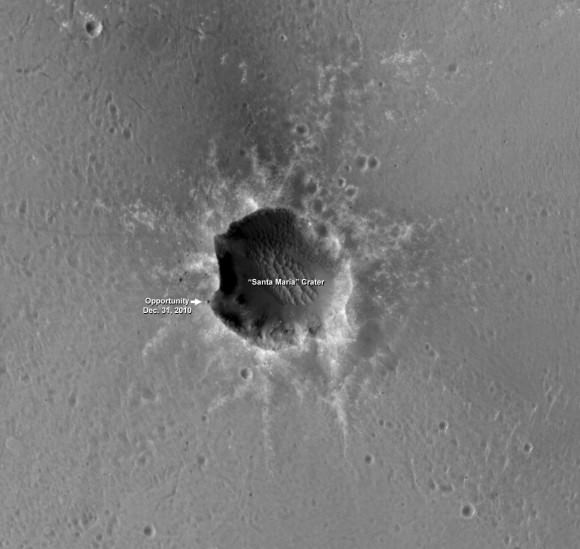
7 Years on Mars: Downloadable Poster
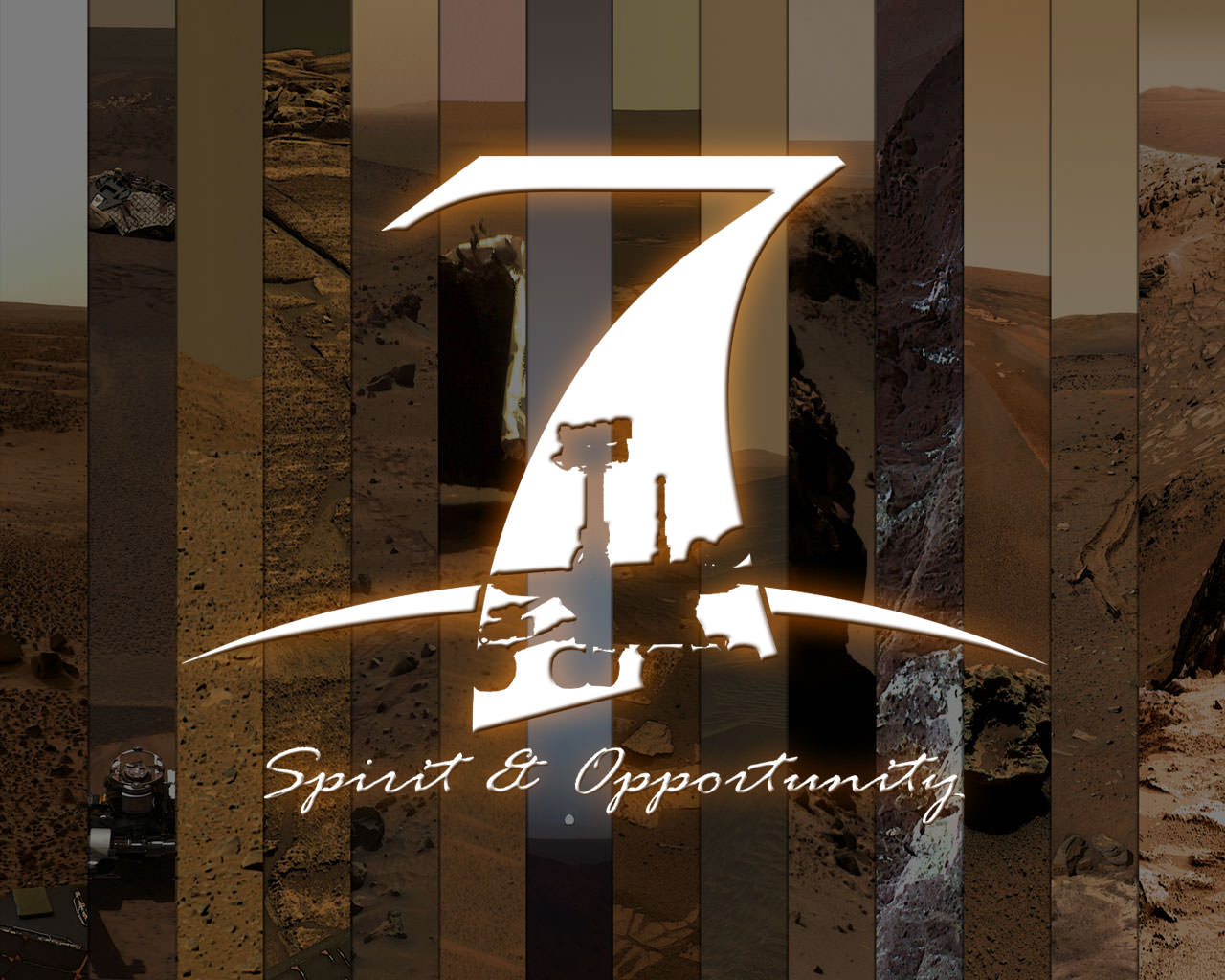
[/caption]
Today, January 3, 2011, is the 7th anniversary of the Spirit rover landing on Mars. In their tradition, Glen Nagle and Stu Atkinson from Unmanned Spaceflight have teamed up to create a poster and poem combo to celebrate. The poster includes scenes from both Spirit’s and Opportunity’s adventures – Glen and Stu challenge you to see how many places you can name. Click on the images or visit Glen’s Astro0 website for higher resolution versions that you can download to print a poster or use for wallpaper.
And happy anniversary to the Mars Exploration Rovers and their science and engineering teams!
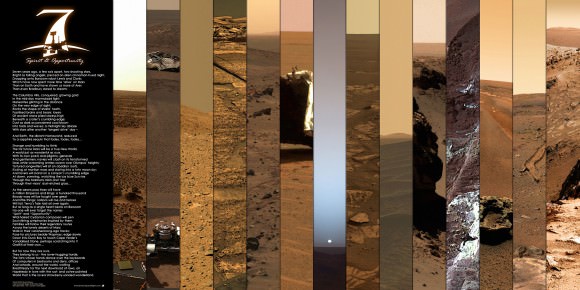
And here’s the poem:
New Years Postcards from the Edge by Opportunity Mars Rover

[/caption]
A robot from Earth is celebrating New Years on Mars by snapping another amazing set of “Postcards from the Edge” while perched near the sharp edge of a crater cliff on the red planet. NASA’s Opportunity rover is now stationed just meters away from a new precipice at the stunningly beautiful crater named Santa Maria. The twin rovers mark their 7th anniversary on Mars this week. See martian postcard mosaics above and below.
Craters expose the hidden history of Mars and permit scientists a path to explore the past geologic epochs which otherwise would remain buried and inaccessible.
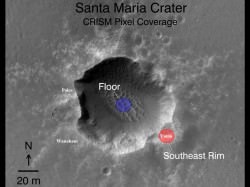
Santa Maria is an exciting find because it appears to be relatively new and unweathered – on the order of possibly just a few million years old. Researchers are eager to drive around the rim in order to explore deposits of water bearing minerals that contain valuable clues to the flow of liquid water on ancient Mars.
The golf cart sized rover arrived this week (Dec. 29) at an outlook nicknamed “Wanahani” near the southern edge of Santa Maria. Opportunity arrived at the western rim of Santa Maria on Dec. 16. Just before Christmas, she drove about 20 meters south along the steep rim from the initial location at Palos Promontory and then bumped incrementally further up to the edge (Sol 2464) .

Opportunity drove within 2.5 meters of the rim and snapped this beautiful panoramic vista of the crater and distant horizon on Sol 2454. Note rover solar panel deck, antennae and sundial at left. Mosaic Credit: NASA/JPL/Cornell, Oliver de Goursac.

Opportunity drove to within 2.5 meters of the rim and snapped this gorgeous panoramic vista unveiling the whole interior on Sols 2453 & 2454. Note the steep walls and sand dunes on the floor. Mosaic Credit: NASA/JPL/Cornell, James Canvin

Opportunity took this panaromic mosaic from “Wanhani” just meters from the crater rim on Dec 29 (Sol 2464). Note rover tracks near rim at left, solar panel at right and numerous ejecta rocks. CRISM mapper results suggest water bearing materials are located at the southeastern section of the crater. Portions of distant Endeavour Crater are faintly visible as bumps on the horizon in the background. Mosaic Credit: NASA/JPL/Cornell, Ken Kremer, Marco Di Lorenzo
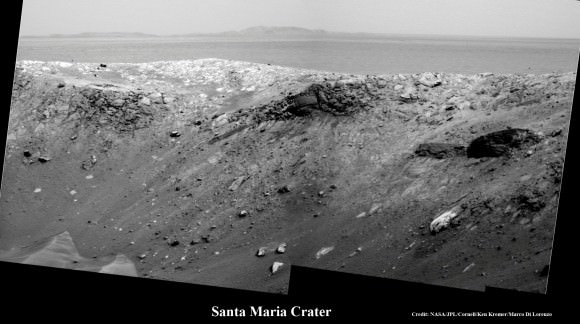
Santa Maria rim up close (80 meters away) and Endeavour rim (6 km away) on the horizon in the distance. Both craters show mineralogical evidence for the past flow of liquid water on Mars and are high priority science targets. Mosaic Credit: NASA/JPL/Cornell, Ken Kremer, Marco Di Lorenzo

Undulating sand dunes on the crater floor and southern portion of Santa Maria, inclined about five degrees. Mosaic Credit: nasatech.net
But there is no time to party and relax. The rover will soon resume driving to the next location – nicknamed “Yuma”. It will continue farther around the football field sized crater – measuring some 90 meters (295 ft) in diameter – to reach the exposures of sulfated hydrates located at the southeast portion of the crater near “Yuma”.
Opportunity must be in position at an important science target before mid January and the onset of solar conjunction and a temporary communications black out with Earth. The rover will remain stationary during conjunction.
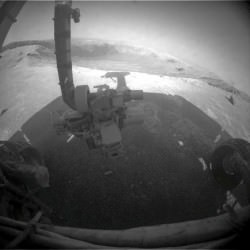
At Wanahani, Opportunity is now hurriedly toiling away over the New Year’s period to collect a pair of long baseline, high resolution stereo image mosaics using it’s panoramic, multispectral imaging camera. See our initial Wanahani mosaics assembled here from the navigation camera images just received on Earth (Sol 2464).
The team is using all 13 filters on the filter wheels of the panoramic camera, according to Ray Arvidson, the deputy principal investigator for the rovers, in an interview from Washington University in St. Louis. Over the course of several days, the left and right “eyes” of the panoramic camera will gather data at various wavelengths to maximize the collection of spectral information about the hydrated minerals located in the craters interior.
Data downlink is limited by the available amount of flash memory aboard Opportunity and is the Achilles heel of rover operations. Virtually all the pictures and science is streaming back to Earth via NASA’s long lived Mars Odyssey orbiter. The team is working to get all the acquired science data offloaded as swiftly as possible,
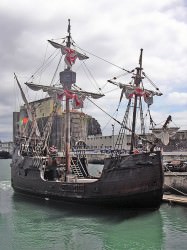
Arvidson said that the team hopes that the meteor impact that excavated the crater also blasted some of these scientifically fascinating rocks free to spots which are more easily accessible – just outside the rim for close up analysis. Additional imaging and spectral data is also being collected from Mars orbit this new year’s weekend in hopes of quickly directing the rover to the best locations for science in the limited time available.
Opportunity will study the relatively fresh and uneroded ejecta rocks using all the instruments located at the end of the robotic arm. One target will be selected for a longer duration study during the period of solar conjunction, said Arvidson.

Opportunity will resume her long term trek to Endeavour crater after the end of solar conjunction in mid February. The western rim of Endeavour is about 6 km distant. Endeavour is a very compelling science target because it shows significant signatures for clay minerals which formed in the presence of neutral bodies of liquid water on Mars, billions of years ago.
Spirit and Opportunity celebrate 7 Years on Mars this month since the dynamic duo landed in January 2004. Look for my story soon.
Gorgeous 3 D Vistas of Martian Crater and Hydrate Minerals at Santa Maria
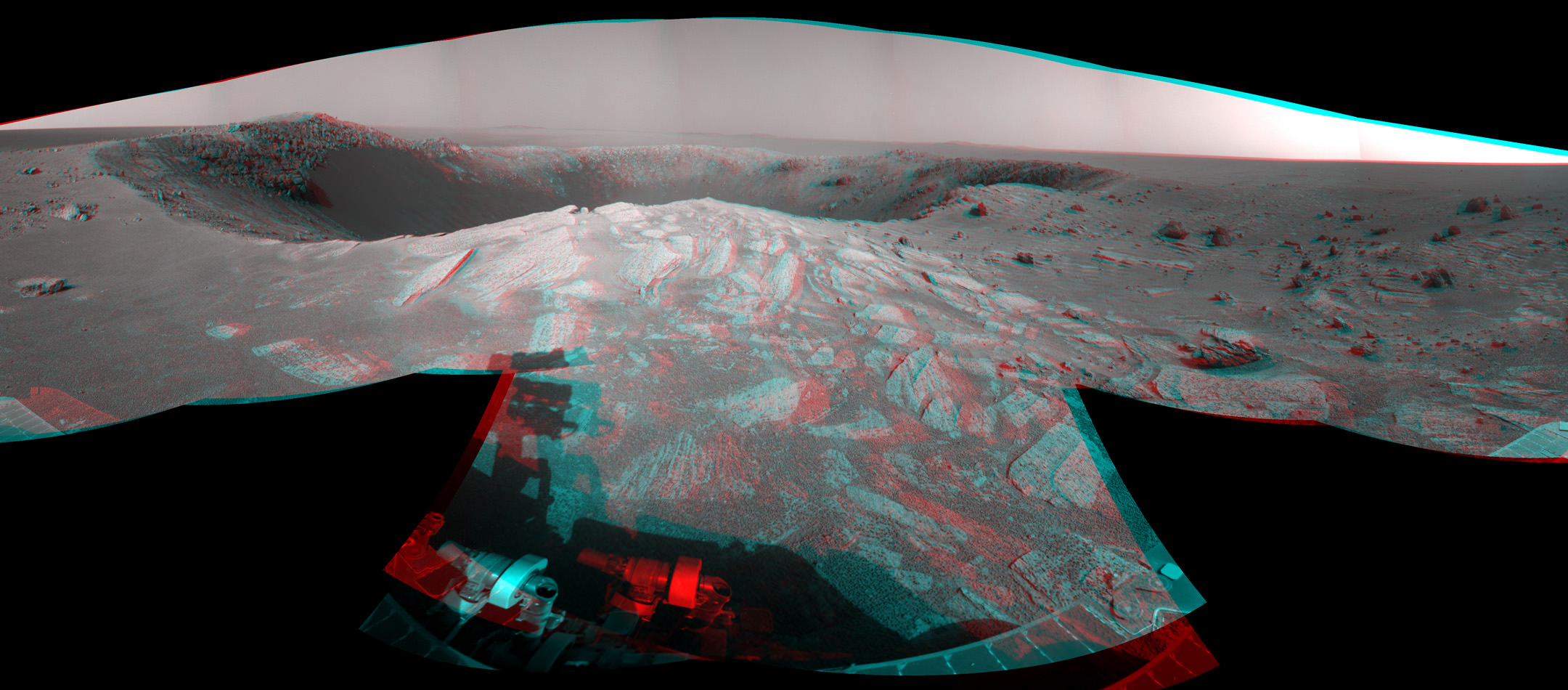
[/caption]
Spectacular new images of a gorgeous gaping hole on Mars are streaming back to Earth from NASA’s Opportunity Mars Rover. So let’s take a 3 D stroll placing all of us at Santa Maria Crater – “On Mars”. Via the photo mosaics above and below, we will circle in three dimensions about the stunningly beautiful Santa Maria Crater. At the southeast portion of the rim, the crater also possesses a scientific goldmine of hydrated mineral deposits. These minerals are indicative of the past flow of liquid water on Mars, an essential requirement for the formation of life.
Opportunity made landfall at the western edge of Santa Maria on Dec. 15 (Sol 2450) after a long and arduous journey of some 19 km since departing from Victoria Crater over 2 years ago in September 2008. She crawled closer to the rim the next day on Dec. 16 (Sol 2451) unveiling a magnificent vista of jumbled ejecta rocks, steep sloped cliffs and undulating sand dunes across the crater floor.
“Santa Maria is a relatively fresh impact crater. It’s geologically very young, hardly eroded at all, and hard to date quantitatively. On the order of 10 million years old or less,” said Ray Arvidson in an interview from Washington University in St. Louis. Arvidson is the deputy principal investigator for the Spirit and Opportunity rovers.

Imagine yourself at the steep cliff walls of Santa Maria crater at a place called Palos. To get a sense of scale in 2 D, human sized figures (2 m tall) have been strategically placed at multiple locations near and far, around and inside this gorgeous panoramic vista. Opportunity drove closer and snapped these images just 2.5 meters from the crater’s edge on Sols 2453 & 2454. Mosaic Credit: NASA/JPL/Cornell, James Canvin. Annotations of Mysterious men in black hats and their cousins, the French climbers by FredK and ElkDanGrove at unmannedspaceflight.com
“Santa Maria is the freshest big guy that Opportunity has seen and has a raised rim,” Arvidson told me. “It is much younger than Endurance Crater which Opportunity visited a few months after landing on Mars way back in 2004 and is roughly the same diameter.” See the entire Opportunity traverse map below.
“The crater is young enough that the interesting hydrate outcrops may not be coated with the nanophase iron oxide dust. There is virtually no erosion. We can see the ejecta rays and blocks,“ said Arvidson.
While sitting just five meters from the rim on Dec. 16, Opportunity imaged the football field sized crater – some 90 m wide – with both its left and right eye navigation cameras. A mosaic of these images was stitched together by NASA to create a stunning 360 degree stereo panoramic vista. The images are snapped from the same height seen by an adult to give the perspective that a human eye would see when standing “On Mars”.
The crater is the centerpiece of the stereo image above, which shows the crater’s sharp rim and rocks ejected from the impact that had excavated the crater. You will need to whip out your red-cyan stereo glasses to experience the full three-dimensional effect of the scene. Be sure to wear the red lens on the left, and try not to fall off the cliff.
Click here for the entire 360-degree high resolution stereo view – its 10 MB in all. South is at the center. North is at both ends. The view is presented as a cylindrical-perspective projection. The wheel tracks left behind in the Martian dirt – as the rover approached the crater – are seen at the far right and are also highlighted in our 2 D mosaic below.
Off in the distance, several portions of the rim of Endeavour Crater are visible as bumps on the horizon. Endeavour is the ultimate target of Opportunity’s long term trek across the Martian dunes at the Meridiani Planum region and is some 22 kilometers in diameter.
“Endeavour shows significant signatures of phylloslicates, or clay minerals, and water bearing sulfate minerals which formed in the presence of liquid water,” Arvidson explained. “The phyllosilicates formed at the crater rim about 3.8 to 4.2 Billion years ago and predate the sedimentary rocks which are younger than 3.8 billion years.”
Pictured below is a collection of stereo photo mosaics for a North to South up close tour around the rim of Santa Maria. Several of the images were created by members of unmannedspaceflight.com.
“Opportunity will drive in a counterclockwise direction around Santa Maria to reach the very interesting hydrated sulfates on the other side. We’ll make 3 stops or more depending on what we see”
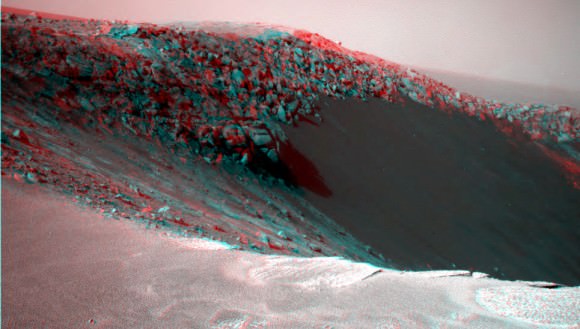
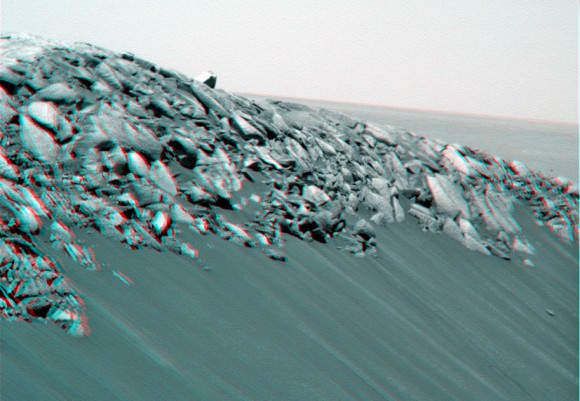
“On Dec. 19 (Sol 2454) we bumped the vehicle even closer to the rim from the initial approach point, to a promontory we’ve nicknamed ‘Palos’, stated Arvidson. “Opportunity was a mere 2.5 meters from the edge. At ‘Palos’, the rover collected the first set of long baseline, high resolution stereo images for creating a 3 D digital elevation map.”
“The coves at Santa Maria will be named after the islands which Columbus visited, using the native American language. All the rocks and boulders strewn about will be named after the sailors on the voyage with Columbus,” explained Arvidson.
“This past weekend we drove about 20 meters southeast towards the second location named ‘Wanahani’. On Tuesday of this week (Dec. 28) we bumped to the edge. The plan is to photograph the ejecta rocks and collect the next set of long baseline, high resolution stereo images.”
The third stop – which must be reached before Solar Conjunction in mid January 2011- will take Opportunity to the science hot spot detected by the powerful CRISM mineral mapping spectrometer circling above Mars aboard NASA’s Mars Reconnaissance Orbiter (MRO).
“With CRISM we are trying to cover all the rim segments to better understand the nature and geologic setting of the iron and magnesium smectite clay mineral exposures. The southeast portion of Santa Maria is generally the location of the CRISM spectra that show hydrated sulfates. Opportunity will go to the southeast rim and try and find a nice outcrop on the rim side to do measurements to field verify the expected mineralogy,” explained Arvidson.
“We might do a toe dip with the wheels but there is no plan to go inside.”
“We will use the Rock Abrasion Tool (RAT) to drill into a selected target. That spot will be named after ‘Columbus’.
The exposures of hydrated sulfates have a bright toned appearence in the images.
“With the sun over the camera’s shoulder there is a phenomenon called opposition effect in which rocks and soils become particularly bright when the sun-camera-surface line up, Arvidson told me. “But, it also may be that the bright looking rocks are intrinsically bright and not coated with the nanophase iron oxide coatings we have seen on previous outcrops. All in the realm of testable working hypotheses.”
“On Dec. 30 we are planning another CRISM spectral mapping campaign with MRO over Santa Maria,” said Arvidson. “Using a new technique which gimbals, or swivels, the CRISM optics we hope to use a pixel overlap technique to improve the ground resolution from 18 meters across to 6 meters across. This data will be used in tactical decisions about where to drive on Mars.”
Read more of my interview with Ray Arvidson in the next feature story describing the exciting plan for science exploration at Santa Maria and Endeavour, the outlook for Spirit and more – along with new mosaics from “Wanahani”.
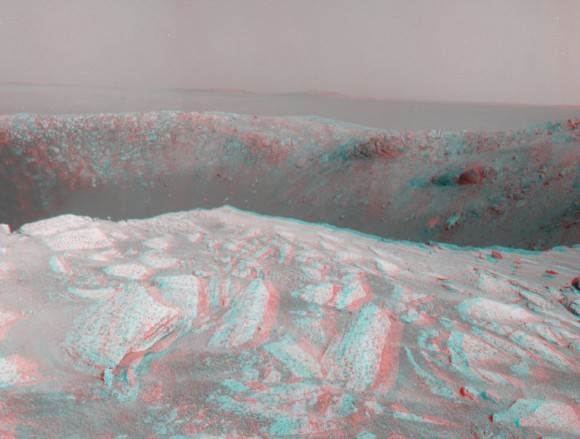
This cropped 3 D segment shows the location of the bright toned exposures of hydrated sulfate minerals detected inside the southeast rim of the steep walled crater. Deposits of hydrated sulfates are an indicator of the past flow of liquid water on Mars. They were detected from orbit by the CRISM mapping spectrometer aboard NASA’s Mars Reconnaissance Orbiter (MRO). Opportunity will go to the SE rim and try to do measurements to field verify the expected mineralogy. Credit: NASA/JPL/Cornell
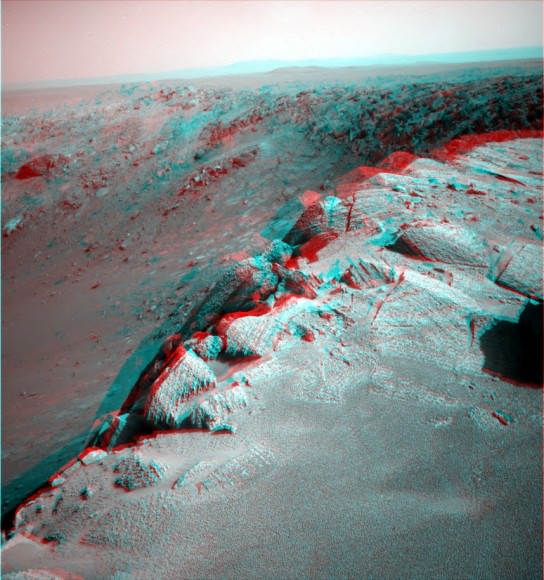
Opportunity will drive to the south rim in January 2011. Cape Tribulation is in the background and located at the western rim of the huge Endeavour Crater which possesses deposits of clay minerals, or phyllosilicates, which form in the presence of neutral liquid water. Cape Tribulation is about 100 meters tall. Credit: NASA/JPL/Cornell/NickF at unmannedspaceflight.com
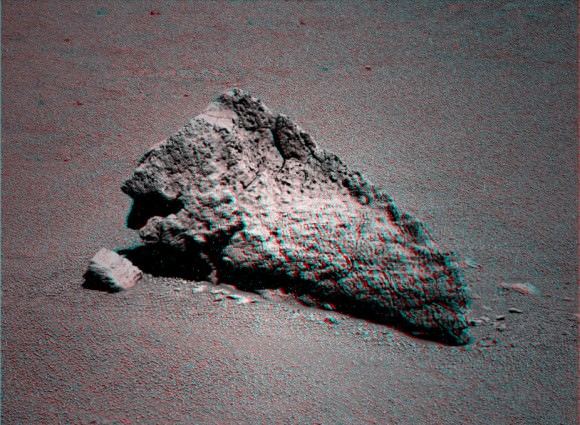
Opportiunity drove past this amazing looking ejecta rock at the outskirts of Santa Maria Crater while approaching the rim. Credit: NASA/JPL/Cornell/Stu Atkinson
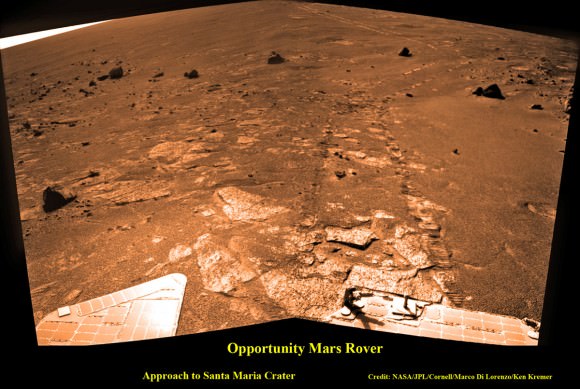
This mosaic of images from Sol 2451 (Not in 3 D) shows the tracks from Opportunity’s wheels on the approach to the steep crater rim on Sol 2450. Credit: NASA/JPL/Cornell, Marco Di Lorenzo, Ken Kremer
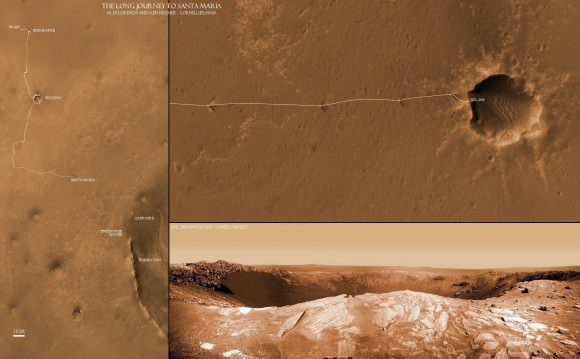
This collage of two maps and a 2 D close up panorama of Santa Maria crater (bottom right) shows the route traversed by the Opportunity Mars rover during her nearly 7 year long overland expedition across the Meridiani Planum region of Mars. Opportunity arrived at the rim of Santa Maria Crater on Dec. 16, 2010 on Sol 2451 and will drive around the edge in a counterclockwise direction to examine rocks which are indicative of the past flow of liquid water. The next destination is Endeavour Crater - some 22 km wide - to investigate water bearing minerals at Cape York and Cape Tribulation which she will reach sometime in 2011. Credit: NASA/JPL/Cornell, Marco Di Lorenzo, Ken Kremer

